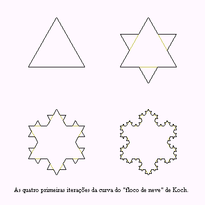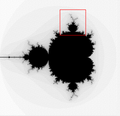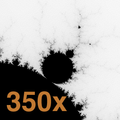Fractal
|
|

Template:Spoken Wikipedia A fractal is a geometric object which is rough or irregular on all scales of length, and so which appears to be 'broken up' in a radical way. Some of the best examples can be divided into parts, each of which is similar to the original object. Fractals are said to possess infinite detail, and they may actually have a self-similar structure that occurs at different levels of magnification. In many cases, a fractal can be generated by a repeating pattern, in a typically recursive or iterative process. The term fractal was coined in 1975 by Benoît Mandelbrot, from the Latin fractus or "broken". Before Mandelbrot coined his term, the common name for such structures (the Koch snowflake, for example) was monster curve.
Fractals of many kinds were originally studied as mathematical objects. Fractal geometry is the branch of mathematics which studies the properties and behaviour of fractals. It describes many situations which cannot be explained easily by classical geometry, and has often been applied in science, technology, and computer-generated art. The conceptual roots of the fractals can be traced to attempts to measure the size of objects for which traditional definitions based on Euclidean geometry or calculus fail.
| Contents |
History

Contributions from classical analysis
Objects that are now called fractals were discovered and explored long before the word was coined. In 1872 Karl Weierstrass found an example of a function with the non-intuitive property that it is everywhere continuous but nowhere differentiable - the graph of this function would now be called a fractal. In 1904 Helge von Koch, dissatisfied with Weierstrass's very abstract and analytic definition, gave a more geometric definition of a similar function, which is now called the Koch snowflake. The idea of self-similar curves was taken further by Paul Pierre Lévy who, in his 1938 paper Plane or Space Curves and Surfaces Consisting of Parts Similar to the Whole, described a new fractal curve, the Lévy C curve.
Georg Cantor gave examples of subsets of the real line with unusual properties - these Cantor sets are also now recognised as fractals. Iterated functions in the complex plane had been investigated in the late 19th and early 20th centuries by Henri Poincaré, Felix Klein, Pierre Fatou, and Gaston Julia. However, without the aid of modern computer graphics, they lacked the means to visualize the beauty of the objects that they had discovered.
Aspects of set description
In an attempt to understand objects such as Cantor sets, mathematicians such as Constantin Carathéodory and Felix Hausdorff generalised the intuitive concept of dimension to include non-integer values. This was part of the general movement in the first part of the twentieth century to create a descriptive set theory; that is, a continuation of the direction of Cantor's research that was able in some way to classify sets of points in Euclidean space. The definition of Hausdorff dimension is geometric in nature, although it is based technically on tools from mathematical analysis. This direction was taken up by Besicovitch, amongst others; it is different in character from the logical investigations that made up much of the descriptive set theory of the 1920s and 1930s. Both of these fields were pursued for some time afterwards, but mainly by specialists.
Mandelbrot's contributions
In the 1960s Benoît Mandelbrot started investigating self-similarity in papers such as How Long Is the Coast of Britain? Statistical Self-Similarity and Fractional Dimension. This built on earlier work by Lewis Fry Richardson. Taking a highly visual approach, Mandelbrot recognised connections between these previously unrelated strands of mathematics. In 1975 Mandelbrot coined the word fractal to describe self-similar objects which had no clear dimension. He derived the word fractal from the Latin fractus, meaning broken or irregular, and not from the word fractional, as is commonly believed. However, fractional itself is derived ultimately from fractus as well.
Once computer visualization was applied to fractal geometry, it presented a powerful visual argument for fractal geometry connecting far larger domains of mathematics and science than had previously been considered, particularly in the realm of non-linear dynamics, chaos theory (though a few use the term xaos instead to differentiate between ordered non-linear behavior and the common meaning of the word), and complexity. One example is plotting Newton's method as a fractal, showing how the boundaries between different solutions are fractal, and that the solutions themselves are strange attractors. Fractal geometry was also used for data compression and for modelling complex organic and geological systems, for example the growth of trees or the development of river basins.
Categories of fractals

|
| Missing image Mandelbrot-similar2.png Zoomed 4x |
 |
 350 times magnification of the Mandelbrot set uncovers fine detail resembling the full set. 350 times magnification of the Mandelbrot set uncovers fine detail resembling the full set. |
Fractals can be grouped into three broad categories. These categories are determined from how the fractal is defined or generated:
- Iterated function systems — These have a fixed geometric replacement rule. Cantor set, Sierpinski carpet, Sierpinski gasket, Peano curve, Koch snowflake, Harter-Heighway dragon curve, T-Square, Menger sponge, are some examples of such fractals.
- Fractals defined by a recurrence relation at each point in a space (such as the complex plane). Examples of this type are the Mandelbrot set and the Lyapunov fractal. These are also called escape-time fractals.
- Random fractals, generated by stochastic rather than deterministic processes, for example, fractal landscapes and Lévy flights.
Fractals can also be classified according to their self-similarity. There are three types of self-similarity found in fractals:
- Exact self-similarity — This is the strongest type of self-similarity; the fractal appears identical at different scales. Fractals defined by iterated function systems often display exact self-similarity.
- Quasi-self-similarity — This is a loose form of self-similarity; the fractal appears approximately (but not exactly) identical at different scales. Quasi-self-similar fractals contain small copies of the entire fractal in distorted and degenerate forms. Fractals defined by recurrence relations are usually quasi-self-similar but not exactly self-similar.
- Statistical self-similarity — This is the weakest type of self-similarity; the fractal has numerical or statistical measures which are preserved across scales. Most reasonable definitions of "fractal" trivially imply some form of statistical self-similarity. (Fractal dimension itself is a numerical measure which is preserved across scales.) Random fractals are examples of fractals which are statistically self-similar, but neither exactly nor quasi-self-similar.
It should be noted that not all self-similar objects are fractals — e.g., the real line (a straight Euclidean line) is exactly self-similar, but the argument that Euclidean objects are fractals is a distinct minority position. Mandelbrot argued that a definition of "fractal" should include not only "true" fractals, but also traditional Euclidean objects, because irrational numbers on the number line represent complex, non-repeating properties.
Because a fractal possesses infinite granularity, no natural object can be a fractal. However, natural objects can display fractal-like properties across a limited range of scales.
Definitions
The defining characteristics of fractals, while intuitively appealing, are remarkably hard to condense into a mathematically precise definition. Mandelbrot defined fractal as "a set for which the Hausdorff-Besicovitch dimension strictly exceeds the topological dimension". For an entirely self-similar fractal, the Hausdorff dimension is equal to the Minkowski-Bouligand dimension.
Problems with defining fractals include:
- There is no precise meaning of "too irregular".
- There is no single definition of "dimension".
- There are many ways that an object can be self-similar.
- Not every fractal is defined recursively.
Examples
Trees and ferns are fractal in nature and can be modelled on a computer using a recursive algorithm. This recursive nature is clear in these examples — take a branch from a tree or a frond from a fern and you will see it is a miniature replica of the whole: not identical, but similar in nature.
A relatively simple class of examples is the Cantor sets, in which short and then shorter (open) intervals are struck out of the unit interval [0, 1], leaving a set that might (or might not) actually be self-similar under enlargement, and might (or might not) have dimension d that has 0 < d < 1. A simple recipe, such as excluding the digit 7 from decimal expansions, is self-similar under 10-fold enlargement, and also has dimension log 9/log 10 (this value is the same, no matter what logarithmic base is chosen), showing the connection of the two concepts.
Fractals are generally irregular (not smooth) in shape, and thus are not objects definable by traditional geometry. That means that fractals tend to have significant detail, visible at any arbitrary scale; when there is self-similarity, this can occur because "zooming in" simply shows similar pictures. Such sets are usually defined instead by recursion.
For example, a normal Euclidean shape, such as a circle, looks flatter and flatter as it is magnified. At infinite magnification it would be impossible to tell the difference between the circle and a straight line. Fractals are not like this. The conventional idea of curvature, which represents the reciprocal of the radius of an approximating circle, cannot usefully apply because it scales away. Instead, with a fractal, increasing the magnification reveals more detail that was previously invisible.
Some common examples of fractals include the Mandelbrot set, Lyapunov fractal, Cantor set, Sierpinski gasket and carpet, Menger sponge, dragon curve, Peano curve, and the Koch curve. Fractals can be deterministic or stochastic. Chaotic dynamical systems are often (if not always) associated with fractals. The Mandelbrot set contains whole discs, so has dimension 2. This is not surprising. What is truly surprising is that the boundary of the Mandelbrot set also has a Hausdorff dimension of 2.
Approximate fractals are easily found in nature. These objects display complex structure over an extended, but finite, scale range. These naturally occurring fractals (like clouds, mountains, river networks, and systems of blood vessels) have both lower and upper cut-offs, but they are separated by several orders of magnitude. Despite being ubiquitous, fractals were not much studied until well into the twentieth century, and general definitions came later.
Harrison [1] (http://math.berkeley.edu/~harrison/research/publications/) extended Newtonian calculus to fractal domains, including the theorems of Gauss, Green, and Stokes.
Fractals are usually calculated by computers with fractal software. See below for a list.
Random fractals have the greatest practical use because they can be used to describe many highly irregular real-world objects. Examples include clouds, mountains, turbulence, coastlines, and trees. Fractal techniques have also been employed in fractal image compression, as well as a variety of scientific disciplines.
Fractal generators
Multi-platform
- Fractint - available for most platforms
- Xaos (http://xaos.sourceforge.net/) - Realtime generator - Windows, Mac, Linux, etc
- FLAM3 (http://flam3.com/) - Advanced iterated function system designer and renderer for all platforms.
- Fract (http://fract.ygingras.net) - A Web-based fractal zoomer
Linux
- Gnofract4d (http://gnofract4d.sourceforge.net/) - Interactive editor which can use many fractint formulas
Windows
- Fractovia's listing of fractal generators (http://www.fractovia.org/fractal_generators/index.shtml) is a fairly complete listing of free fractal generators.
- Online Fractal Generator (http://www.wackerart.de/fractal.html) Java-Plugin required.
- Ultra Fractal (http://www.ultrafractal.com/) - popular software for Microsoft Windows
- ChaosPro (http://www.chaospro.de) - for Microsoft Windows
- MSPlotter (http://www.aswsoftware.com/products/msplotter/msplotter.shtml) a great free Windows-based fractal generator, using fractals to create bitmap images and AVI video clips.
- Fractal Explorer (http://www.eclectasy.com/Fractal-Explorer/) - free Windows-based generator
- Sterling Fractal - Advanced fractal-generating program by Stephen Ferguson.
Mac
- Altivec Fractal Carbon (http://www.daugerresearch.com/fractaldemos/altivecfractalcarbon.html) Mac-based benchmarking utility, using fractals to determine performance.
MorphOS
- Zone Explorer (http://www.elena-fractals.it/) Write your own formulas, including color, and browse your fractal fast in a PPC processor.
See also
- butterfly effect
- chaos theory
- complexity
- constructal theory
- fractal art
- fractal landscape
- fractal metaphysics
- graftal
- Hausdorff dimension
- Gaston Julia
- list of publications in mathematics#Fractal geometry
- Benoît Mandelbrot
- non-linear dynamics
- turbulence
- How Long Is the Coast of Britain? Statistical Self-Similarity and Fractional Dimension
External links
- The Chaos Hypertextbook (http://hypertextbook.com/chaos/). An introductory primer on chaos and fractals.
- Fractals, in Layman's Terms (http://www.fractalus.com/info/layman.htm)
- Fractals, fractal dimension, chaos, plane filling curves (http://www.cut-the-knot.org/Curriculum/index.shtml#f)
- Fractal properties (http://math.rice.edu/~lanius/fractals/self.html)
- Information on fractals from FAQS.org (http://www.faqs.org/faqs/fractal-faq/)
- Fractovia (http://www.fractovia.org/) - authoritative source of fractal generators, as well as a listing of tutorials regarding fractals in general, and specific programs.
- Fractal examples (http://www.stilldreamer.com/)
- Fractal Artwork, Spot files for Fractal Explorer (http://www.phidelity.com/ph2/fractals/)
- C82 (http://www.c82.net)
- Fractal landscapes (http://www.fractal-landscapes.com)
- Fractal dimensions (http://www.jracademy.com/~jtucek/math/dimen.html)
- Fractal calculus (http://math.berkeley.edu/~harrison/research/publications/)
- Mitchell-Green gravity set (http://fred.mitchellware.com/fractals)
- Fractal Dimension (http://www.math.vt.edu/people/hoggard/FracGeomReport/node1.html)
- Several fractal art galleries with parameter files and programs for re-creating the images (http://www.faemalia.net/Fractals)
- Fractal Zoom movies (http://www.ericbigas.com/fractals)
- Natural fractals in Grand Canyon (http://astronomy.swin.edu.au/~pbourke/fractals/grandcanyon/)
Further reading
- Barnsley, Michael F., and Hawley Rising. Fractals Everywhere. Boston: Academic Press Professional, 1993. ISBN 0120790610
- Falconer, Kenneth. Fractal Geometry: Mathematical Foundations and Applications. West Sussex: John Wiley & Sons, Ltd., 2003. ISBN 0470848618
- Jürgens, Hartmut, Heins-Otto Peitgen, and Dietmar Saupe. Chaos and Fractals: New Frontiers of Science. New York: Springer-Verlag, 1992. ISBN 038797903
- Mandelbrot, Benoît B. The Fractal Geometry of Nature. New York: W. H. Freeman and Co., 1982. ISBN 0716711869
- Peitgen, Heinz-Otto, and Dietmar Saupe, eds. The Science of Fractal Images. New York: Springer-Verlag, 1988. ISBN 0387966080
|
Topics in mathematics related to space | Edit (http://en.wikipedia.org/w/wiki.phtml?title=Template:Space&action=edit) |
| Geometry | Trigonometry | Non-Euclidean geometry | Fractal geometry | Algebraic geometry | |
| Topology | Metric geometry | Algebraic topology | Differential geometry and topology | |
| Linear algebra | Functional analysis |
da:Fraktal de:Fraktal eo:Fraktalo es:Fractal fa:برخال fi:Fraktaali fr:Fractale it:Frattale he:פרקטל ja:フラクタル nl:Fractal pl:Fraktal pt:Fractal ru:Фрактал sl:Fraktal sv:Fraktal th:แฟร็กทัล zh:分形


